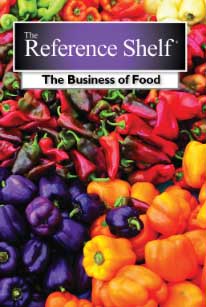“Business of Food” offers plenty for thought

“The Business of Food” (photo by H.W. Wilson)
“The Business of Food” is my first foray into The Reference Shelf series. Regarding “The Reference Shelf,” “the books in this series contain reprints of articles, excerpts from books, addresses on current issues, and studies of social trends in the United States and other countries,” according to the preface.
“The Reference Shelf” provides a clear overview of many current topics, and is an excellent resource for any one doing research needing that wide-angle lens approach.
“The Business of Food” is no exception. It introduces us to a wide and eclectic range of food topics and issues in an impartial, user-friendly way. First section up is the new farm movement. I’m quite drawn to books which talk about buying a farm, restoring it, and meeting the daily challenges of making a living by farming. “Fifty Acres and a Poodle” comes to mind, as does “The Dirty Life.” This section, however, reminds us that sustaining an organic farm is backbreaking work, and often farms fail.
I’m also all for the slow, localvore, and organic movements, and live by these movements according to the dictates of my budget and conscience. But the thing is, many low-income individuals don’t have this option. “The Business of Food” reminds us that there are huge obstacles for this population to local, slow, and/or organic food. For example, if you don’t have a car and there’s no public transportation, how do you get to the market? Should you get there, how do you afford what’s for sale? Should you afford what is there, how do you prepare and store it if you don’t have adequate refrigeration, pots and pans, or even basic ingredients like salt and pepper?
Next section up is “Media and How-to Cooking.” Since I don’t watch TV, I am taking the book’s word that there are many cooking shows on television now, often hosted by celebrities. Apparently, food has moved beyond something we eat as a meal to something we “experience.” Yet “3.1 percent of U.S. households experience hunger,” according to the children’s coalition at http://www.cwla.org. Some of us Americans, then, are too occupied with trying not to starve, and do not have the luxury of “experiencing” meals.
Regarding section three, “Big Food Business,” articles discuss what happens when an organic wholesaler like Trader Joe’s moves into an area that has a thriving food coop. Articles also touch on genetic engineering and food, and how the junk food industry is successfully mounting pressure against the World Health Organization in regard to promoting its products in developing countries.
There are several articles regarding the role food critics and writers have on what we eat. Also, you can read about eating from the wild. (I skipped over this article because it includes a bunny.) This section also talks about the rituals of preparing food, and sustainability, food reform, and the environmental and health impact farming has on us and our earth.
What about restaurants? Learn about Cause, a DC-based restaurant that gives all of its profit to charity, and read about other restaurants like Eleven Madison Park in New York City; dinner there runs into four figures.
In “The Business of Food,” whatever food topic is explored always contrasts with the fact that many people in this country and our world go without it. In this way, this book keeps a solid, clear balance. To have food is to live. Everything else is gravy.





